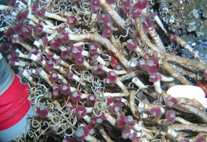Abstract
Tetragonopterus anomalus Steindachner was briefly described in July of 1891 (Steindachner 1891a:173) solely based on the holotype, which measured 144 mm (probably SL). Subsequently, in October, Steindachner (1891b:369) illustrated and redescribed the species in more detail. The type specimen was collected in the Paraná River, in the vicinity of Corrientes, Argentina. A few months before, in April of the same year, Perugia (1891:643) described Tetragonopterus nigripinnis, from de la Plata River. Ulrey (1895:273) considered T. anomalus as a junior synonym of T. nigripinnis, but did not justify the reasons for this synonymy, which was later supported by Perugia (1897:25). Eigenmann (1903:145) proposed the genus Markiana, with T. nigripinnis (= M. nigripinnis) as type species (type by monotypy), but did not mention T. anomalus in the description of this genus. However, in his later review of Markiana, Eigenmann (1918:124) confirmed T. anomalus as a junior synonym of Markiana nigripinnis, followed also by Fowler (1948:136). Nonetheless, uncertainty about the taxonomic status of T. anomalus, a poorly known species, led Lima et al. (2003:161) to consider it an inquirenda species in Characidae, and this status has been maintained until the present (Eschmeyer 2015).

